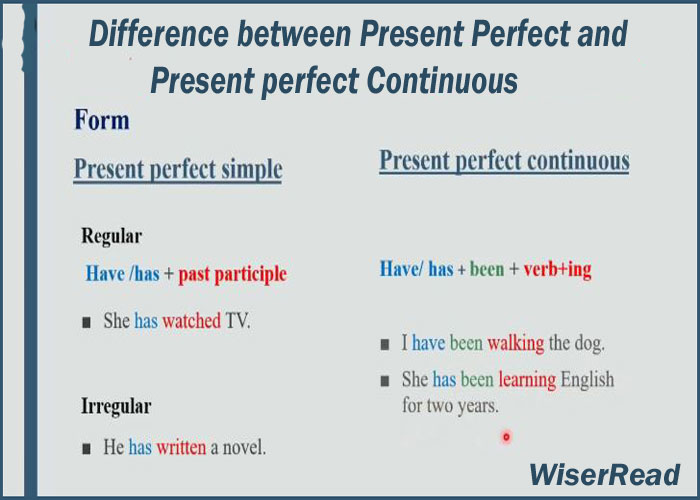We use the Present Perfect and Present Perfect continuous with the verbs and it’s part of Tense. In a sentence, the present perfect is used to define the action to the past and continue the work. We use here as a verb ‘have or have’. Otherwise, in a sentence, the present perfect continuous is used to define an action to the past and presently continuing the work for understanding. We use here as a verb ‘have been or has been’ and include ‘ing’ in the action verb.
Definition of the Present perfect
The actions occurred in the past time sometime before a not long time ago or continue to the present that are called present perfect. We use both the present perfect tense (have or has + past participle form).
Examples of Present Perfect tense
Your concept will be clear to see these examples here. Now, let’s start with some examples of the present perfect tense.
- I have worked with my friends.
- He has completed various kinds of stories.
- She has gone there.
- We have watched Drama series in our home.
- They have played Volleyball on the field.
- The driver has driven the car exactly.
- I have helped him to do the work.
There are also relative examples and details you can get here the Difference between has and had.
Present perfect Continuous tense definition
The actions occurred in the past time sometimes before a not long time ago or continuing to the present that is called present perfect continuous. We use both the tense (have or has + been+ action verb + ing and object).
Examples of Present Perfect Continuous
Your concept will be clear to see these examples here. Here, let’s start with some examples of the tense.
- I have been comp ting the task at a certain time.
- We have been watching the Turkey Drama series for five hours.
- He has been playing tennis for a long time.
- She has been living in New York since March.
- We have been shopping at this festival for three hours.
- I have been singing different kinds of songs, especially modern songs.
- They have been playing football on that field for 2 hours.
There are also relative examples and details you can get here for clearing your grammatical concept of the Difference between has been and has been.
What is the difference between Present Perfect and Present Perfect Continuous Tense?
Present Perfect VS Present Perfect Continuous with differences are given here in the table.
| Present Perfect | Present Perfect Continuous tense |
| The actions that occurred in the past time sometimes before a not long time ago or continue the present | The actions in the past time sometimes before a not long time ago or continuing the present. |
| Structure: Subject + Have/ has +Past participle form of verb + object. | Structure: Subject + Have/ has +been+ ing form of action verb + object. |
| Focuses on the result of the sentence. | Focuses on the activity of the sentence. |
| Examples: · I have worked with my family. · He has completed the various kinds of stories. | Examples: · We have been watching the Turkey Drama series for five hours. · He has been playing tennis for a long time. |
Present Perfect vs Present Perfect Continuous
Both the present perfect and present perfect continuous tenses deal with actions that started in the past and have some connection to the present, but they do so in slightly different ways. Imagine them as two tools in your grammatical toolbox, each suited for specific tasks.
Present Perfect
Focuses on the result or completion of an action. It’s like a snapshot of the final outcome, regardless of how long it took or how it unfolded. Think of it as the “achievement unlocked” screen after completing a level in a game.
Examples:
- I have eaten (achievement: full stomach)
- She has written a novel (achievement: finished book)
- We have been to Paris (achievement: visited the city)
Doesn’t specify the duration or frequency of the action. You don’t know if I just finished eating a bite or devoured a feast, when she started writing the novel or how long it took, or if we visited Paris once or ten times.
Present Perfect Continuous
Focuses on the ongoing nature of an action or the process of doing it. It emphasizes the duration or repeatedness of the action, highlighting that it started in the past and continues to the present, or has just recently finished. Think of it as the progress bar filling up as you play the game level.
Examples:
- I have been eating all day (ongoing action: feeling full)
- She has been writing a novel for months (ongoing process: still writing)
- We have been thinking about going to Paris (repeated action: considering the trip)
Highlights the duration or frequency with adverbs or time expressions. These can include “all day,” “for months,” “lately,” “recently,” “just,” etc.
Here’s a helpful analogy
Imagine you’re painting a picture. The present perfect tells you the picture is painted (result), while the present perfect continuous tells you you’re still in the process of painting (ongoing action).
Choosing the right tense
- Use the present perfect when the focus is on the completed action or its result, and the duration or frequency is not important.
- Use the present perfect continuous when you want to emphasize the ongoing nature of the action, how long it has been happening, or that it has just finished.
Final Notice
We use for, since, and how long with the perfect continuous to talk about ongoing single actions. For: they’ve been playing MLB for an hour. I expected that the content will help you to know about the difference between Present Perfect and Present Perfect continuous tense. Besides, if you think any problems face to understanding the tense then feel free to ask.

